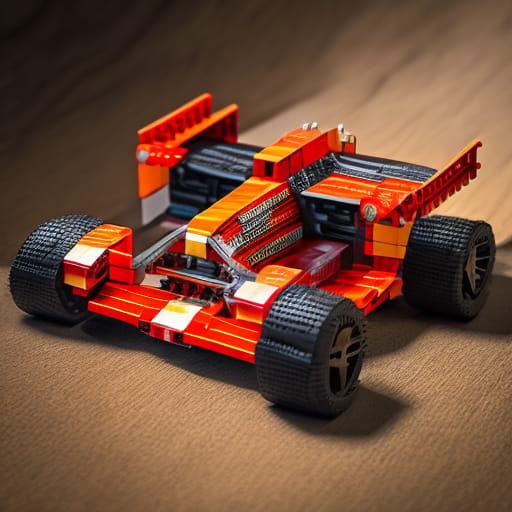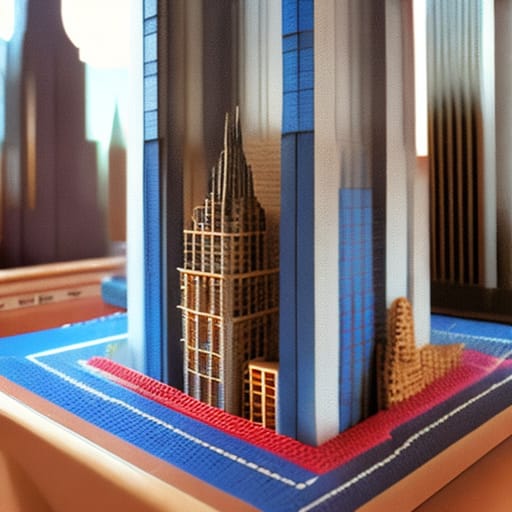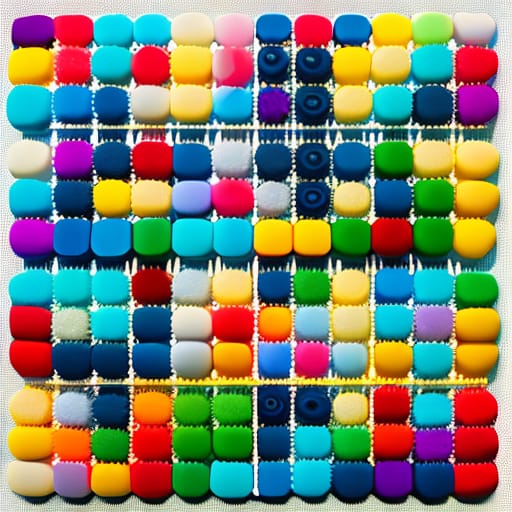Miniature building blocks are a classic toy loved by children and adults alike. These small, interlocking plastic bricks inspire open-ended creativity and imagination. This versatile toy also helps develop key skills like fine motor skills, problem-solving, spatial reasoning, and engineering concepts.
In this beginner’s guide, you’ll learn all about miniature building blocks including:
- What are miniature building blocks
- Benefits and features
- Best starter sets for different ages
- Top brands
- Creative ideas and tips
- Building challenges for kids
- Tips for parents and educators
- FAQs
Whether you’re considering your child’s first set of blocks or looking for a new building challenge as an adult, this guide covers it all. Come learn why miniature building blocks have been cherished by over 100 million kids and adults worldwide for decades!
What are Miniature Building Blocks?
Miniature building blocks, also referred to as building bricks or construction toys, are small interlocking plastic blocks that can be assembled into virtually anything a child or adult can imagine.
The pieces come in basic geometric shapes blocks, rectangles, cylinders, arches, angled pieces, etc. and attach together through studs and tubes. This simple but versatile system allows for endless configuration and creativity.
Classic sizes of miniature building blocks include:
- Standard size – approx. 0.5” x 1” brick size
- Mini size – approx. 0.4” x 0.6” brick size
- Micro size – approx. 0.25” x 0.5” brick size
- Nano size – approx. 5mm x 5mm bricks
The small size provides opportunity for attention to detail and development of fine motor skills. The creative free-form play encourages imagination, problem solving skills, spatial reasoning, and exploration of engineering concepts.
Benefits and Features
Building blocks might seem like simple children’s toys, but their benefits extend far beyond just playtime enjoyment. Here are some of the key benefits of these versatile construction toys:
Develops Motor Skills
Assembling the interlocking bricks helps improve pincer grasps needed for writing tasks later on. Connecting rows of blocks across different planes also improves hand-eye coordination.
Fosters Creativity and Imagination
With no instructions, miniature building blocks allow open-ended creativity. Children are free to build whatever they can imagine, from castles to race cars. This open play builds divergent thinking.
Teaches Early Engineering and Math
As kids explore stability, balance and structure, they pick up important engineering and physics concepts. Simple counting, patterning, and spatial reasoning also comes into play.
Promotes Problem Solving
Miniature building blocks offer safe ways for kids to create, test, fail, and problem solve over and over until they achieve the result they envisioned. This develops critical thinking at a young age.
Improves Focus and Patience
Following intricate designs or overcoming failed structures requires sustained attention, focus and determination. Being absorbed in creative workflow develops concentration.
Builds Confidence
Having the ability to build any structure they dream up gives kids a great sense of independence and achievement. Completing a challenging model project cultivates self-confidence.
As children grow with building blocks, they’ll gain all these benefits and more. But adults can enjoy stimulating their creativity with these toys too!
Great for All Ages
From master builders making complex designs to casual hobbyists who find the methodical assembly relaxing after a long day, collecting and constructing miniature builds appeals to all ages.
Top Miniature Building Block Brands
There are a few major players in the miniature construction block space. Here are the most popular miniature building block brands:
LEGO – The original and most iconic building block brand around for over 50 years. High quality bricks in standard, mini, and micro sizes.
Mega Bloks – Budget-friendly building bricks from Mattel, sized compatible with leading brands.
Kreo – Hasbro’s building bricks with licensed themes from Transformers, Star Wars, and other pop culture icons.
PixelBlocks – Specialty brand of nano-sized building bricks just 5mm x 5mm in size. Great for micro projects.
Cobi – Known for their military themes and realistic vehicle model kits. Bricks made in EU.
Oxford – Affordable basics bricks for educators and budget buyers.
Magformers – Magnetic construction sets that allow building on vertical surfaces.
There are also various niche brands and off-brands offering compatible bricks often at lower price points. Quality can vary though so beware of pieces not aligning.
When first starting out, LEGO, Mega Bloks, and Kreo offer trusted quality. As skills grow, exploring specialty brands like Cobi, PixelBlocks, and Magformers allows for new challenges and building techniques.

Best Starter Sets by Age
Miniature building blocks span a wide range of ages. With different sizes for tiny hands to master intricate designs, there’s something for every builder’s skill level.
We’ve highlighted some of the best introductory building block sets for the main age groups:
Toddlers (1-3 years)
- LEGO DUPLO My First Numbers Train
- 30 colorful, oversized pieces
- Introduces counting and early math
- Chunky bricks for little hands
- MEGA Bloks 80-piece Big Building Bag
- Assorted classic bricks
- Bright colors & textures
- Storage bag for tidy clean-up
- PixelBlocks Race Car Building Kit
- Nano 5mm sized bricks
- Build a sleek red race car
- Micro building improves dexterity
Preschoolers (3-5 years)
- LEGO Classic Creative Fun Set
- 221 assorted elements
- Open-ended building
- Great value starter set
- Kreo Transformers Build-a-Figure
- Make a 2” tall robot figure
- Combine with other Kreo sets
- Familiar license kids love
School-Age (5-9 years)
- LEGO Creator 3-in-1 Townhouse Toy Store
- 334 pieces, 3 models in 1 set
- Bricks plus windows, doors, etc.
- Challenging build with guide
- Mega Bloks ProBuilder Empire State Building
- 396 pieces
- Historical landmark model
- Illuminated interior
Tweens (9-12 years)
- LEGO Creator Expert Roller Coaster
- 1,124 pieces
- Moving coaster cars
- Satisfying complex build
Teens (13+ years)
- Cobi Small Army WWII Battle Set
- 788 realistic pieces
- Tank and Anti-tank building guides
- High quality hybrid bricks
With themed sets featuring favorite characters and advanced sets to build defined models or explore free-building creativity, starter kits are available for any age.
Creative Ideas and Building Tips
The open-ended build and play nature of most miniature building block sets fosters endless creativity. But if you need some inspiration, here are creative ideas for sparking the imagination:
Build Different Architectural Structures
Recreate famous landmarks and buildings like the:
- Empire State Building
- Transamerica Pyramid
- Burj Khalifa
- Palace of Versailles
- Colosseum
Add creative twists by swapping materials like building the Taj Mahal out of blue transparent bricks instead of white.
Design Your Dream House
Let kids plan their perfect home with favorite features like a pool, home theater, giant playroom, waterslide, or unicorn stable!
Construct a Mini City
Make a complete metropolis with homes, office high rises, hospitals, parks with ponds, construction zones, restaurants, sports stadiums and more. Add play features like remote control cars zipping down roads or model trains connecting neighborhoods. Develop your own urban plan.
For more ideas, we’ve compiled this list of 102 Cool Things to Build with LEGOs!
And don’t just stick to buildings – the micro size of bricks makes it perfect for miniature models of anything like:
- Phone
- Computer
- Space station
- Pirate ship
- Robot
- Unicorn
- Dragon
Let kids reimagine ordinary objects tiny proportions. Get creative! Building regular items scaled down creatively reinforces comparative sizing and spatial skills.
General Building Tips
Here are some pro building techniques to make your structures sound:
- Overlap bricks in each row by half increments to evenly distribute weight
- Make walls 2 or more studs thick for stability
- Include corner pillars every 12-20 stud lengths to prevent buckling
- Angle walls, pillars and supports to reinforce and strengthen designs
- Utilize arches and triangles naturally sturdy shapes
Follow these tips for constructing solid framework for endless creative projects!
Popular Add-On Elements & Accessories
While just the plain building blocks allow for almost unlimited building potential, specialty elements help enhance designs. Popular add-ons include:
Specialty Bricks & Tiles:
- Windows
- Doors
- Roof tiles
- Baseplates (builds connect together)
Mini Figures:
- People
- Story characters
- Animals
Wheels & Axles:
- Cars
- Trucks
- Trains
Advanced Mechanics:
- Gears
- Motors
- Contraptions
By incorporating additional elements, kids can build intricate towns with bustling residents, safari scenes full of wildlife, construction sites loaded with vehicles or medieval castles defended by knights in armor!
Sets focused on mechanics also introduce key engineering and physics concepts powering movement in builds through gears, axles, pulleys and motors.
Expand the creative play potential with add-on accessory packs and expansions!

Great Building Challenges for Kids
Guiding kids through graded building challenges helps them progress their construction skills in a structured way. It feels rewarding conquering more complex projects over time.
Consider these building challenges that instruct step-by-step to achieve defined models:
By Skill Level
- Level 1
- Vehicles – car, truck, helicopter etc.
- Level 2:
- Animals – dog, dinosaur, shark etc.
- Level 3:
- Buildings – house, restaurant, fire station etc.
- Level 4:
- Scenes – city block, river ecosystem etc.
By Pieces
- 10 pieces – micro model
- 50 pieces – mini model
- 100 pieces – basic model
- 500 pieces – detailed model
- 1000+ pieces – advanced model
By Time
- 15 minutes – micro model
- 30 minutes – simple structure
- 60 minutes – complex structure
- Multi-day project – intricate scene
Varying the challenge criteria keeps building block play engaging as kids skills progress. Check out this book STEAM Play & Learn for even more guided building activities.
Why Parents and Educators Love Them
With the wide range of developmental benefits they offer, it’s easy to see why miniature building blocks have stood the test of time as a cherished toy for educators and parents.
Value
High quality building brick brands like LEGO retain their value extremely well and can often be resold used at comparable prices years later. Other kits make ideal hand-me-downs to younger siblings, cousins, or as donations when outgrown.
Reusable & Recyclable
Bricks stick together as tightly when new making even vintage hand-me-down used sets still perfectly usable for new generations of kids. The simplicity means no batteries required.
LEGO bricks are also made from strong, durable ABS plastic featuring reinforcements like strengthening tubes inside. Their high quality ensures bricks appearance and function remains pristine for years.
When it does come time to retire well loved sets, all LEGO elements can be fully recycled. They boast one of the highest recycling rates at 90% reclaimed and reused in new LEGO products.
Educational
As highlighted throughout this guide, miniature building blocks offer an array of important developmental benefits beyond just play. Integrating them in both home and institutional learning curriculums enhances retention through hands-on engagement.
Promote Bonding
As a toy that appeals to both kids and adults, building block playtime provides a common interest for bonding and mentorship across ages. Grandparents can teach grandkids special techniques they once used. Parents can impart wisdom taking on role as “master builder”.
Bringing generations together to imagine, collaborate and create lasting memories cementing family connections. For many, nostalgia itself makes the bricks special, kindling their innovative spirit first sparked years ago by these iconic construction toys.
Final Thoughts
For over half a century, miniature building blocks have sparked creativity and joy across generations. With benefits that span developmental skills, STEM learning, creative potential and family connections, it’s no wonder they remain one of the most cherished toys today.
This guide just scratches the surface for all the fun ways open-ended building play can enrich kid development and quality family time.
We recommend starting with a brand name basic starter kit with lots of classic bricks then expanding into more specialized elements. Take on building challenges together and proudly display your micro structures!
Endless creative construction awaits mini builders of all ages. So open those boxes, dump out the bricks, and let your imagination build something amazing!
Frequently Asked Questions
Q: At what age can babies start playing with blocks?
A: Miniature building bricks are generally recommend for ages 3+ for safety due to small pieces. However chunky, non-interlocking infant blocks suitable from 12 months old are available to introduce block stacking concepts.
Q: How many LEGO bricks are there in the world?
A: LEGO produces over 19 billion elements a year. In total over 600 billion LEGO bricks have been manufactured since 1958. Enough for ~86 bricks per person alive today!
Q: What are some good techniques for sturdy construction with interlocking bricks?
A: Some pro building tips include overlapping bricks in each row by half increments to distribute weight evenly, making walls 2+ studs thick for stability, incorporating corner pillars for support, and utilizing triangle shapes to reinforce designs.
Q: What kinds of specialty bricks help expand creative play possibilities?
A: Adding elements like windows, doors, mini figures, animals, wheels, and advanced mechanics like gears or motors opens more creative potential. Specialty bricks let kids build detailed towns with residents and decorative touches.
Q: What are some good ways to store completed block structures long-term?
A: Carefully transfer structures to sturdy cardboard boxes with tissue paper/bubble wrap cushioning underneath. Seal box with packing tape, label contents, and store flat on surfaces away from direct sunlight and moisture. This protects intricate block creations.
Q: Can I wash or clean my building bricks if they get dirty?
A: Yes, you can wash blocks in a sink or buckets, gently scrubbing and rinsing in plain water. Allow pieces to fully air dry before use to prevent sticking and mold growth. For a deeper clean, use hydrogen peroxide or gentle detergent solutions.
Q: Where can I buy individual brick replacement pieces or parts packs?
A: LEGO offers a replacement parts service directly through their website. Just search for the part name or design number needed. Many common elements ship free or very low cost, making it easy to replace one-off specialty pieces needed to complete builds.
